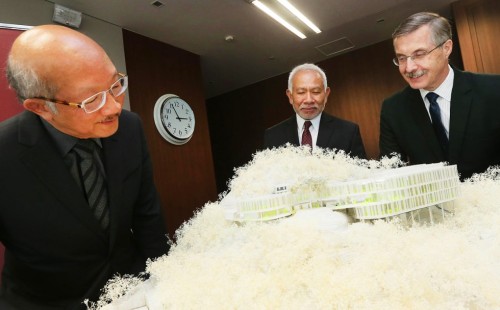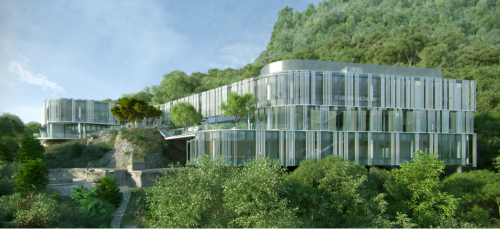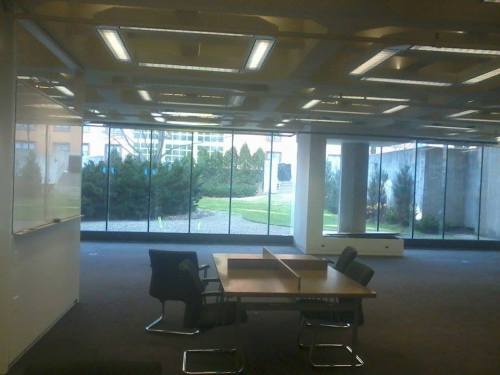
Architect Francis Yan (left), Gavin Tu, and Chicago Booth’s Associate Dean for Global Outreach, Bill Kooser. SCMP
The physical conditions of the site are extreme because of the steep gradient. The non-physical conditions, I contend, are as extreme. Consider that the existing structures on the site are not merely historic as buildings; they played a vivid role in the bloody 1967 Leftist Riots. During the turmoil, the British government in Hong Kong used emergency powers to detain 52 key figures in leftist organizations at Mount Davis; the procedures used in detaining and imprisoning such individuals were undoubtedly an infringement of human rights.
We also cannot gloss over the fact that, as a practical matter, Hong Kong has confiscated public land for private use. To address this issue the architects must try very hard to protect, mimic, and even enhance the natural beauty of the site, while maintaining public access to its trails. Lastly, Hong Kong prides itself on its architectural identity. Bing Thom Architects must capture this architectural ethos as best as it can.
Bing Thom Architects was a smart choice for this project for two reasons. Already mentioned in our previous post is the Hong Kong ties of Bing Thom (the firm also has an office in Hong Kong and the lead architect on the project, Francis Yan, is a Hong Konger). Second, BTA has completed numerous projects in its home base of Vancouver, which like Hong Kong is a high-density coastal city with beautiful mountain scenery.
With the caveat that renderings can never be a substitute for seeing the real finished product, let’s take a look at how well the design as we see it now addresses the challenges of the site.
The steep gradient is met in a rather conventional way, stilts. While stilts are preferable to a solid foundation that would needlessly scar the greenery of the site, it is a pity that the firm did not find a more creative engineering solution. On the other hand, the architects try to compensate by making stilts into something of a motif–and it is used to great effect on the ground-level floor.
Providing an open space underneath the middle section of the upper level, which is supported by diminutive stilts, helps solve two problems at once. It allows the two historic buildings to be left practically untouched, and able to be looked at and experienced as individual buildings by visitors and the public. As claimed in Booth’s application to the Town Planning Board, the main building “float[s] atop the existing heritage structure.” The difficult history of these buildings calls for such a deferential treatment. The open arcade in the middle of the building, along with the wide entrance that features the kind of fountain typical of public squares, also serves to welcome the public into the complex and allows the public to access the landscaped terrace below and the trails beyond without having to enter the school itself.
Ultimately, the historic site is far more accessible than it ever has been–a fact that critics of the project have overlooked. While the decrepit site was apparently open to film crews (Ang Lee’s Lust, Caution shot a scene at the former detention center), it was closed to almost everyone else. The buildings will of course be restored as part of their adaptive reuse–and for the first time since their infamous use decades ago these buildings will actually have a function, and though a private function, a deserving one: education.
Booth has even proposed a small museum exhibit to educate the public about the former detention center, though I cannot tell from the floor plans exactly what space is designated for this purpose. It supposedly will be in a “former interrogation room.”
The design also shows a concerted effort by BTA to minimize the visual impact of the building. At 52,000 square feet, the building is as small as it could reasonably be. It utilizes a green roof (by now, very common for new constructions) to mimic the lushness of the site and of course to make the building more sustainable. Most of all, it attempts to make itself seem smaller by closely hugging the mountain and taking an undulating, naturalistic (BTA says “sensuous”) ribbon form that closely matches the curves of the mountainside which no doubt inspired it. The exterior material of the building is light and mostly glass; its blueness provides a nice harmony with the color of the sea. Various landscaping features attempt to enhance the natural beauty–most successful is a circular bench and terrace made from stone (see below); the shrubs and other plantings in and around this area will, I hope, become partially overgrown and seem to be part of nature.

The design itself is attractive but not mind-blowing. Perhaps that is a good thing. Hong Kong architecture is characterized by being boldly contemporary and, at its best, highly visually engaging. The design is both of those things, and so it is certainly appropriate for Hong Kong. Hong Kong is also defined by the marriage of old and new. By skillfully weaving historic buildings into a modern ensemble, BTA’s design embodies Hong Kong architecture. Primarily, however, the design is an intelligent response to the challenges of the site. The architecture is eye-catching, but overall it treads carefully–with good reason.
Like other buildings in Hong Kong, the entrance floor is the middle level. This configuration is a happy one, for it means that students and faculty will be forced to constantly pass through the “public sphere” of the building–which, with its impressive views, is also a kind of “sky lobby.” The floor plans seen above give an idea of how BTA may have created the design around programmatic needs: these space dictates, then, are another reason in addition to the shape of the mountain for the contours of the building, since the architects wanted to keep it as small as they could while meeting the client’s needs.
Just one thing truly irritates me about the design. On the roof, a semi-translucent fence obscures mechanical equipment. This trick is age-old, and very uncreative. However, I suspect that this design choice was made because the architects wanted to keep the building’s visual height (the height excluding the fence) as low as possible.
(N.B.: Booth’s current Hong Kong campus is located in a custom-designed space at Hong Kong’s Cyberport that opened for students in August of 2014, and will move to the new site when the new building is completed.)















